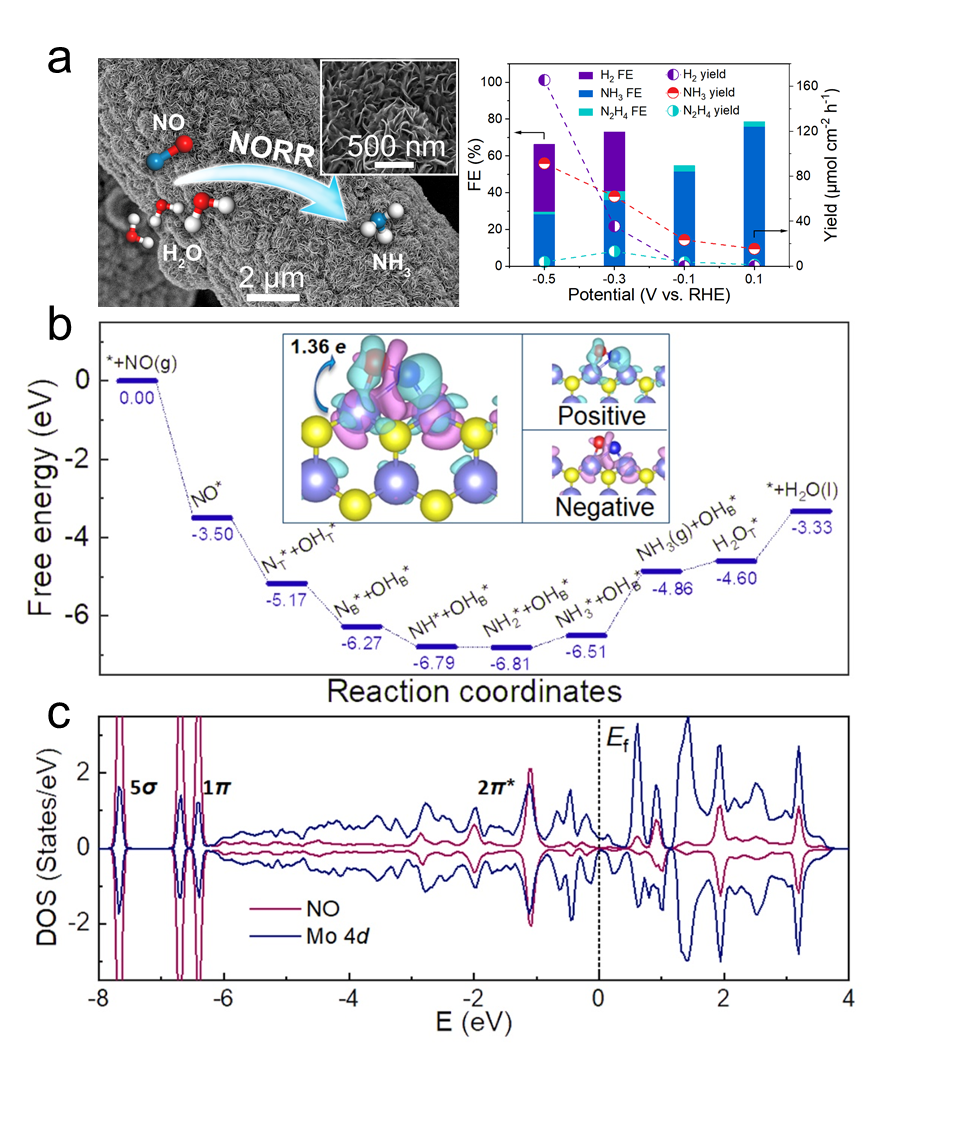Recently, associate Prof. Dongwei Ma at School of Materials cooperating with Prof. Xuping Sun from University of Electronic Science and Technology of China reported that molybdenum disulfide nanosheets (MoS2/GF) grown on graphite felt were used as a highly active and stable electrochemical nitric oxide reduction catalyst. The ammonia yield and ammonia Faraday efficiency of 99.6 µmol cm−2 h−1 and 76.6% were obtained. In addition, inspired by zinc-air battery, a zinc-nitric oxide (Zn-NO) battery system was developed for the first time using MoS2 as a catalytic electrode. The battery has the function of simultaneously synthesizing ammonia and supplying external power, with a power density of 1.04 mW cm-2 and ammonia yield of 411.8 µg h−1 mgcat-1 (Figure a). This work was published on the top journal in chemistry, “Angewandte Chemie International Edition”, entitled “High-Performance Electrochemical NO Reduction into NH3 by MoS2 Nanosheet”.

Figure a) MoS2/GF behaves as a superb and durable electrocatalyst for ambient NH3 generation via NO reduction in acids, capable of attaining a Faradaic efficiency of 75.9% and a large NH3 yield of up to 91 µmol cm−2 h−1. The MoS2-based Zn–NO battery delivers a power density of 1.04 mW cm−2 with an NH3 yield of 452 µg h−1 mgcat−1. DFT calculations reveal that the positively charged Mo-edge sites facilitate NO adsorption/activation via an “acceptance-donation” mechanism and disfavor the binding of protons and the coupling of N-N bond. b) Free energy landscape for NORR on MoS2 (101) along the optimal path passing. c) Local DOS of the adsorbed NO and its bonded Mo atoms.
Theoretical calculations show that the potential-determining step, the electrochemical step with the largest free energy uphill, of the NORR over MoS2 (101) is the hydrogenation of NH2*+OHB* to NH3*+OHB* with the free energy uphill of only 0.30 eV (Figure b). The calculated ultralow limiting potential of −0.30 V coincides well with the excellent electrocatalytic activity observed in the experiments. In addition, an analysis of the electronic structure for the NO adsorbed system shows that the adsorption of NO molecules with the elongation of the N-O bond by ~ 0.16 Å is accompanied with significant charge redistribution as revealed by the charge density differences. Bader charge analysis confirms that a large number of electrons transfer from MoS2 (101) to the adsorbed NO (1.36 e). Intriguingly, charge density differences indicate a two-way mode for charge transfer, i.e., both electron accumulation and depletion on the adsorbed NO and the MoS2. In detail, the electron accumulation on the NO occurs mainly on the antibonding orbital, and electron depletion on the bonding orbital, which leads to the weakening of the N-O bond. Thus, NO chemisorption on MoS2 (101) belongs to the so-called electron “acceptance-donation” mechanism, similar to the activation of N2 molecule. This picture can be further supported by the densities of states shown in Figure c, from which we can see the 2π* antibonding orbitals of the adsorbed NO are significantly occupied, and there is also significant overlap of the electronic states between NO and its bonded Mo atoms.
This work not only provides us with a catalyst that can efficiently convert nitric oxide into ammonia under environmental conditions, but also successfully develops a new Zn-NO battery system, which provides a new strategy for ammonia production and broadens the application field of zinc-based batteries.
Prof. Xuping Sun from University of Electronic Science and Technology of China, Associate Prof. Dongwei Ma from School of Materials, and Prof. Xiaodong Guo from Sichuan University are the co-corresponding authors of this paper. Yuanyuan Wang, a master in the School of Materials, has completed all the theoretical calculations in this paper. This work was supported by the National Natural Science Foundation of China.
The link of this paper: https://doi.org/10.1002/anie.202110879.